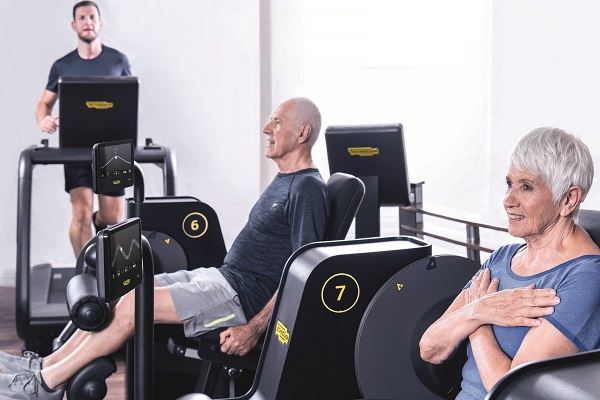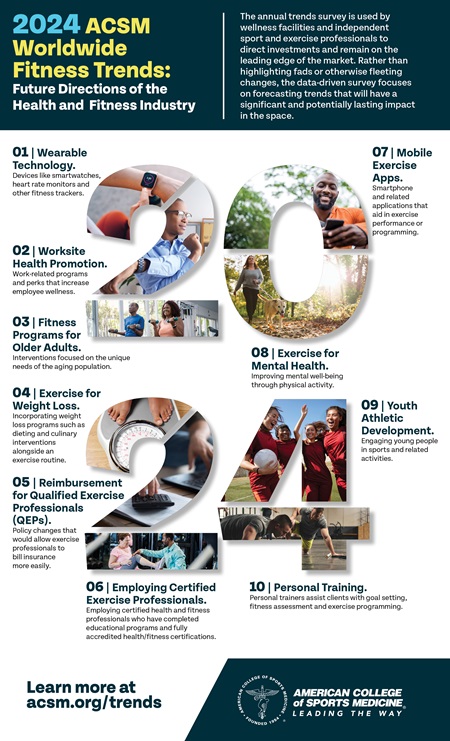Worksite health promotion and exercise for older adults among top trends in 2024 ACSM worldwide survey

While again identifying wearable technology as being the top industry trend for 2024, the latest worldwide fitness trends survey from the American College of Sports Medicine (ACSM) has identified links between exercise and health promotion as being of increased significance.
The newly published 2024 ACSM Worldwide Fitness Trends: Future Directions of the Health and Fitness Industry, published in the January/February issue of ACSM’s Health & Fitness Journal.
Now in its 18th year, the annual survey, which gathers data from thousands of respondents to predict the trends which will impact the fitness industry, suggest the growing move for the fitness industry to engage with the medical profession.
With wearable technology identified as the top trend since 2016 - with the exception of being third in 2018 and second in 2021 - the survey notes increased interest in using devices such as smart watches, fitness trackers and heart rate monitors to deliver real-time information about pulse, step counts and sleep, providing exercise professionals the opportunity to tailor programs for their clients.
In addition to wearable technology, the second trend for 2024, worksite health promotion, entered the top 10 for the first time suggesting a correlation between employees getting back to work ‘in office’ post-pandemic and the development of work-related programs and perks that increase employee wellness.
Commenting on this, Trends co-author and spokesperson A’Naja Newsome, Ph.D., ACSM-CEP, advised “we are noticing that exercise professionals prioritise health-related outcomes of fitness programs. Due to the COVID-19 pandemic, we are starting to see fitness being used to reduce symptoms of mental illness and to increase health related quality of life.”
While trends vary across the globe, exercise for improved health outcomes is prevalent everywhere, including exercise for weight loss in response to the obesity epidemic, exercise for older adults and exercise as medicine.
Overall, the top three trends for 2024 seem to paint a picture of a fitness landscape in which people remain focused on the potential of wearable tech, more employers are considering the benefits of facilitating healthy behaviours in employees and older adults make up an increasing proportion of the population in need of physical activity.

Survey top 10:
1. Wearable technology - ever evolving it increasingly being used to personalise programs and track progress.
2. Worksite health promotion. Ill health among working-age people is increasing dramatically with an associated economic cost: in the UK, The Health Foundation estimates over 7 million people are struggling with a health condition which limits their work and earning potential. Providing health-promoting opportunities at work, such as fitness facilities or preventative screenings, can lower insurance costs, increase workplace productivity and improve mental health.
3. Fitness programs for older adults: the Western world has an ageing population and old age leads to an increased risk of chronic illness, cognitive impairment, stroke and falls. Regular aerobic and muscle-strengthening physical activity can maintain independence and quality of life for longer, so this is an obvious space for the fitness industry to step into.
4. Exercise for weight loss is up from eighth in 2023 and recognises the role regular exercise can play in improving metabolic function and reducing body fat, as well as how obesity and its comorbidities are on the rise.
5. Reimbursement for Qualified Exercise Professionals (QEPs) is testament to the part qualified exercise professionals can play in the health care continuum. An ACSM Task Force was formed in 2021 to advocate for policy change to allow insurance billing for patient services performed by QEPs to improve physical activity outcomes and quality of life.
6. Employing Certified Exercise Professionals - reflects the increasing professionalisation of the industry with health and fitness providers hiring trained professionals to lead fitness programs.
7. Mobile exercise apps are in the top ten for the first time. This trend reflects the proliferation of smart phone apps now available to support individuals in their training programs, to track progress, acquire skills and be part of a supportive online community.
8. Exercise for mental health is number eight and acknowledges the increasing awareness, in both the industry and consumers, that movement can improve mental health, cognition and mood.
9. Youth athletic development. ACSM recommends exercise professionals considering speciality training to work with this population.
10. Personal training - a popular trend throughout the lifespan of the survey and indicates that one-to-one training still has major appeal.
Recorded between the 11th to 15th spots:
11. Lifestyle medicine (promoting healthy behaviours).
12. Outdoor fitness activities (less popular since the pandemic).
13. Health and wellness coaching (health promotion and lifestyle medicine programs).
14. Functional fitness training, yoga, exercise is medicine (encouraging health care providers to use exercise as part of a recovery plan).
15. Traditional strength training (surprise drop from second last year).
With specific reports for Australia, Europe, Brazil, Mexico, Portugal and Spain, along with - for the first time - individual reports have been prepared for Chile, Italy and UAE, the Australian findings saw exercise for mental health as the top trend, followed by fitness programs for older adults and group training.
In the UAE exercise for weight loss was the top trend, followed by personal training and strength training. Boxing, kickboxing and mixed martial arts were number five.
Since 2006, the ACSM Worldwide Fitness Trends survey has gathered input from 2,000 clinicians, researchers and practitioners in the fitness industry and is designed to provide input on fitness trends as opposed to ‘fads’ that have little or no impact on the industry.
Click here for more information about the Global 2024 Trends Survey.
Image credit: Technogym.
Related Articles
4th January 2024 - AUSactive identifies exercise for mental health as the year’s top fitness trend
29th December 2023 - Trends, openings, plans and legal matters. Our top news stories of the year. Part 2: April to June
23rd November 2023 - Global Wellness Summit spotlights 12 trends as movements not just fleeting fads
6th July 2023 - AUSactive invites industry input in predicting hottest fitness trends for 2024
13th April 2023 - FIBO announce winners of Innovation and Trend Awards 2023
17th March 2023 - Sport Singapore to launch National Registry of Exercise Professionals
3rd February 2023 - Global Wellness Summit report identifies 12 Wellness Trends for 2023
14th January 2023 - Les Mills identifies three key fitness trends set to shape 2023
2nd January 2023 - ACSM predicts wearable technology as the top fitness trend for 2023
30th December 2022 - AUSactive survey suggests fitness programs for older adults will be key exercise trend in 2023
9th December 2022 - ClassPass and Mindbody look back at fitness and wellness trends for 2022
7th December 2022 - New report identifies six megatrends anticipated to reshape Australian sport
19th November 2022 - PureGym analysis of Google search data reveals 2023’s Biggest Fitness Trends
21st July 2022 - New research confirms wearable fitness trackers provide motivation to exercise
15th November 2020 - Health2Sync study reveals benefits of fitbit wearable device integration with diabetes care
3rd November 2020 - ESSA releases free ebook promoting physical activity benefits for older adults
7th June 2019 - YMCA Victoria aquatic centres launch Older Adults Water Safety Awareness series
26th April 2019 - Study shows wearable fitness technology gets cancer survivors active
12th August 2017 - Fitness Australia’s Bill Moore explains benefits of Australian Register of Exercise Professionals






